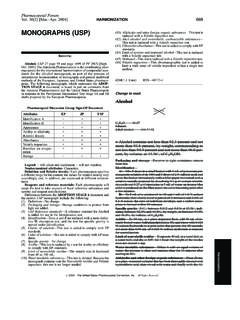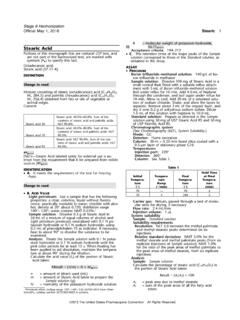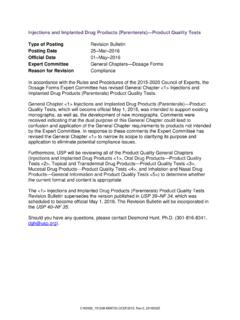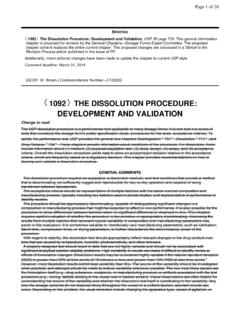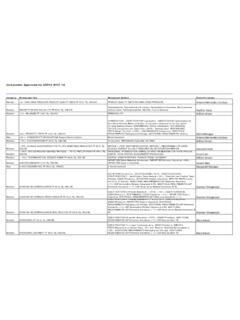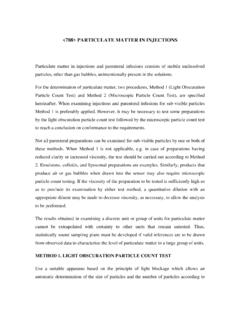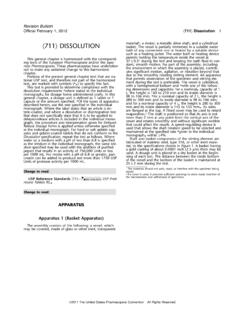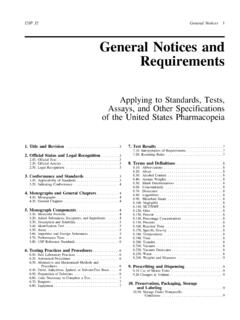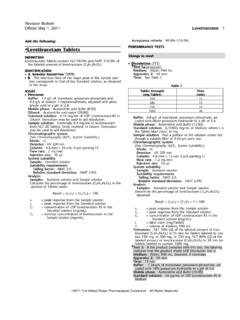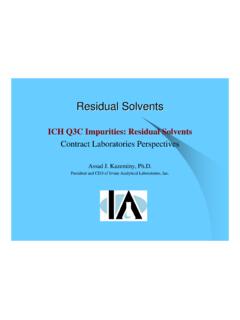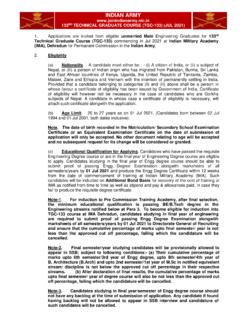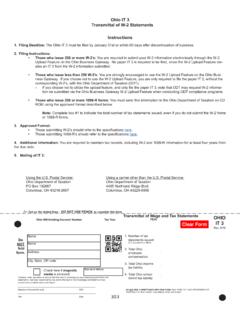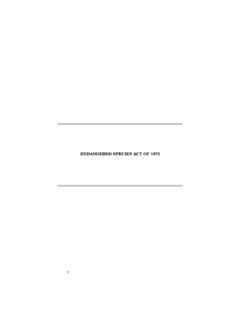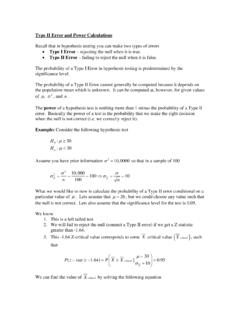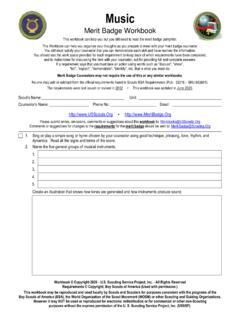Transcription of <381> Elastomeric Closure for Injections Type of Posting ...
1 <381> Elastomeric Closure for Injections Type of Posting Revision Bulletin Posting date 29 Dec 2017. Official date 01 Jan 2018. Expert Committee General Chapters Packaging and Distribution Reason for Revision Compliance In accordance with the Rules and Procedures of the 2015-2020 Council of Experts, the General Chapters Packaging and Distribution Expert Committee has revised General Chapter <381>. Elastomeric Closure for Injections . In USP 41 NF 36 General Chapter <381> Elastomeric Closure for Injections references <231> Heavy Metals. With the impending omission of <231> on January 1, 2018, <381> was revised to include the necessary information to allow execution of the outlined test.
2 The <381> Elastomeric Closure for Injections Revision Bulletin will supersede the currently official General Chapter. The Revision Bulletin will be incorporated in the Second Supplement to USP 41 NF. 36. Should you have any questions, please contact Desmond Hunt, (301-816-8341 or C199717-M99140-GCPD2015, Rev. 0 20171229. Revision Bulletin Official January 1, 2018 381 1. 381 Elastomeric CLOSURES FOR Injections . INTRODUCTION. Elastomeric closures for containers used in the types of preparations defined in the general test chapter Injections and Im- planted Drug Products 1 are made of materials obtained by vulcanization (cross-linking) polymerization, polyaddition, or poly- condensation of macromolecular organic substances (elastomers).)
3 Closure formulations contain natural or synthetic elastomers and inorganic and organic additives to aid or control vulcanization, impart physical and chemical properties or color, or stabi- lize the Closure formulation. This chapter applies to closures used for long-term storage of preparations defined in the general test chapter Packaging and Storage Requirements 659 , Injection Packaging. Such closures are typically used as part of a vial, bottle, or pre-fill syringe pack- age system. This chapter applies to closures formulated with natural or synthetic Elastomeric substances.
4 This chapter does not apply to closures made from silicone elastomer; however, it does apply to closures treated with silicone ( , Dimethicone, NF). When performing the tests in this chapter, it is not required that closures be treated with silicone, although there is no restriction prohibiting the use of siliconized closures. This chapter also applies to closures coated with other lubricious materials ( , materials chemically or mechanically bon- ded to the Closure ) that are not intended to, and in fact do not provide, a barrier to the base elastomer. When performing the tests, closures with lubricious nonbarrier coatings are to be tested in their coated state.
5 The following comments relate solely to closures laminated or coated with materials intended to provide, or in fact function as, a barrier to the base elastomer ( , PTFE or lacquer coatings). It is not permissible to use a barrier material in an attempt to change a Closure that does not meet compendial requirements to one that does conform. Therefore, all Physicochemical Tests apply to the base formula of such closures, as well as to the coated or laminated Closure . To obtain Physicochemical Tests results, the tests are to be performed on uncoated or nonlaminated closures of the same Elastomeric compound, as well as to the laminated or coated Closure .
6 The Functionality Tests apply to and are to be performed using the laminated or coated elasto- meric Closure . Biological Tests apply to the lamination or coating material, as well as to the base formula. Biological Tests may be performed on the laminated or coated Closure , or they may be performed on the laminate/coating material and the uncoated or nonlaminated closures of the same Elastomeric compound. In the latter case, the results are to be reported separately. The base formula used for physicochemical or biological tests intended to support the compendial compliance of a barrier-coated Closure should be similar to the corresponding coated Closure in configuration and size.
7 For all Nephelometry, Turbidimetry, and Visual Comparison 855 tests performed on any Closure type, it is important to docu- ment the Closure being tested, including a full description of the elastomer, and any lubrication, coating, laminations, or treat- ments applied. This chapter states test limits for Type I and Type II Elastomeric closures. Type I closures are typically used for aqueous prepa- rations. Type II closures are typically intended for nonaqueous preparations and are those which, having properties optimized for special uses, may not meet all requirements listed for Type I closures because of physical configuration, material of con- struction, or both.
8 If a Closure fails to meet one or more of the Type I test requirements, but still meets the Type II require- ments for the test(s), the Closure is assigned a final classification of Type II. All Elastomeric closures suitable for use with injecta- ble preparations must comply with either Type I or Type II test limits. However, this specification is not intended to serve as the sole evaluation criteria for the selection of such closures. It is appropriate to use this chapter when identifying Elastomeric closures that might be acceptable for use with injectable preparations on the basis of their biological reactivity, their aqueous extract physicochemical properties, and their functionality.
9 The following Closure evaluation requirements are beyond the scope of this chapter: The establishment of Closure identification tests and specifications The verification of Closure product physicochemical compatibility The identification and safety determination of Closure leachables found in the packaged product The verification of packaged product Closure functionality under actual storage and use conditions The manufacturer of the injectable product (the end user) must obtain from the Closure supplier an assurance that the com- position of the Closure does not vary and that it is the same as that of the Closure used during compatibility testing.
10 When the supplier informs the end user of changes in the composition, compatibility testing must be repeated, totally or partly, depend- ing on the nature of the changes. Closures must be properly stored, cleaned for removal of environmental contaminants and endotoxins, and, for aseptic processes, sterilized prior to use in packaging injectable products. CHARACTERISTICS. Elastomeric closures are translucent or opaque and have no characteristic color, the latter depending on the additives used. They are homogeneous and practically free from flash and adventitious materials ( , fibers, foreign particles, and waste rub- ber.)
